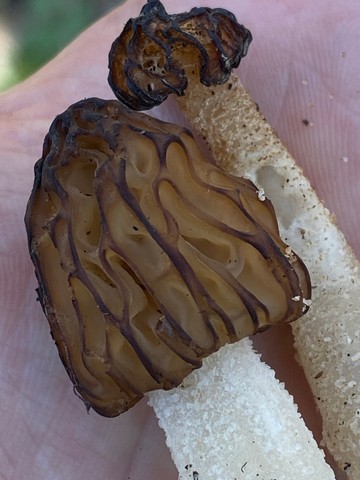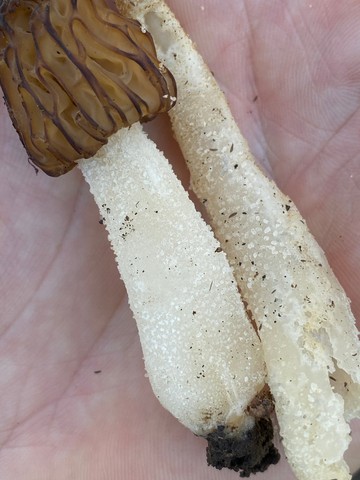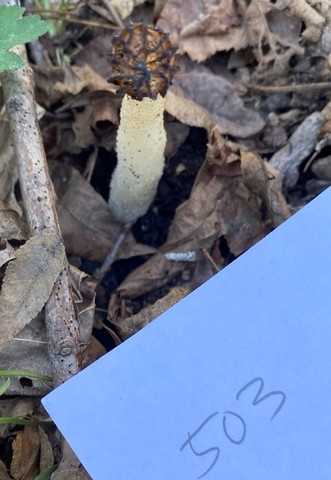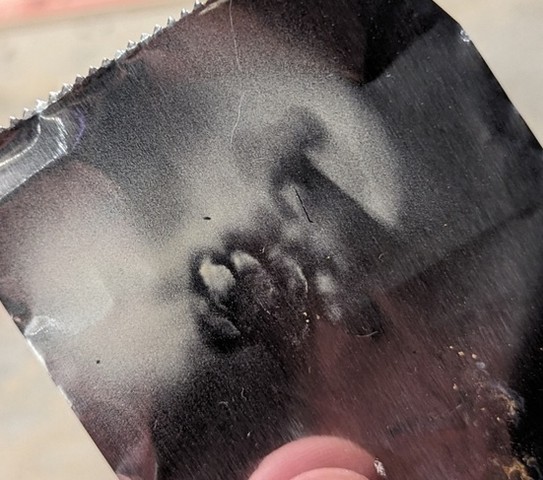Half-free Morel
Morchella punctipes
Life > Fungi > Ascomycota > Pezizomycotina > Pezizomycetes > Pezizomycetidae > Pezizales > Morchellaceae > Morchella
Description
- This mushroom is hollow on the inside, brittle, and thin-fleshed. The inside texture is roughened.
- The cap is skirt-like, meaning that the bottom margin is halfway free from the stem and fused to the stem for the upper half. This feature separates it from other Morels in Nebraska.
- The cap shape is conic (cone-shaped), round, or oval when young, becoming mostly conic with age.
- The stem has an obvious rough, granular texture that rubs off and the color is white to light yellow
- When young, the mushroom's cap is generally taller than the stem. With age, the stem becomes significantly taller than the cap.
- The cap is composed of pits and ridges mostly tan colored when young. In mature specimens, the pits are yellowish-brown to brown to gray-brown and the ridges are darker than the pits. The ridges turn black with age. The ridges are mostly vertically oriented with occasional horizontal ribs.
- This mushroom is saprobic and mycorrhizal.
Habitat
Half-Free Morels occur in sites ranging from deep-shaded forest ravines to open Bur Oak hilltop prairies to floodplain Cottonwood forests. It commonly grows near recently dead Elms and Cottonwoods, feeding on the recently deceased roots, but is found near many other tree species. It can be found growing alone or scattered. If one is found, others may be close by within eyesight.
Abundance & Fruiting Period
This spring-time mushroom appears in mid-April through May at Indian Cave. In northern Nebraska, it can still be found in mid-June.
Statewide Range: Found in eastern Nebraska in wooded habitats, possibly found throughout the state. (Distribution Map)
North America: Found throughout central to northeastern North America. (Distribution Map)
This spring-time mushroom appears in mid-April through May at Indian Cave. In northern Nebraska, it can still be found in mid-June. It may not appear in dry years.
Similar Species in Nebraska
- The Common Morel is the most common morel in Nebraska.
Interesting facts
- punct-ipes means "spotted stem".
- This mushroom was once called M. semilibera in North America as the European version until DNA testing showed that the North American version was a distinct species.
Edibility and Toxicity
Edible, but taste not as exciting as other morels (Kay, Sikes, & Morse, 2022).
Morels must be thoroughly cooked to be safely eaten! Poisonings from raw or undercooked morels are serious and have led to death (Demorest, 2024).
Observations
April 16th, 2024 Indian Cave State Park
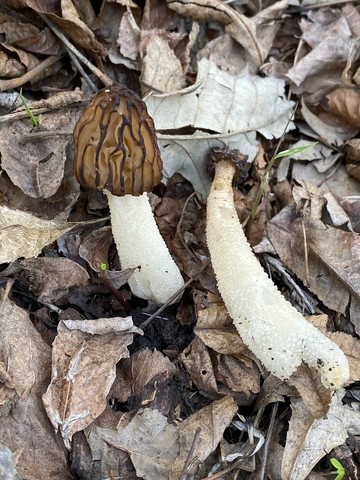
503
- Growing from soil in upland Oak/Hickory woodland.
- Spore Print: whitish to light buff
References
Arora, D. (1986). Mushrooms demystified: a comprehensive guide to the fleshy fungi. Berkeley (California): Ten Speed Press.
Demorest, H. (2024). Outbreak Linked to Morel Mushroom Exposure — Montana, 2023. MMWR. Morbidity and Mortality Weekly Report, 73. https://doi.org/10.15585/mmwr.mm7310a1
Kay, S., Sikes, B., & Morse, C. (2022). A New Guide to Kansas Mushrooms. University Press of Kansas.
Kuo, M. (2024, April). Morchella punctipes. Retrieved from the MushroomExpert.Com Web site: http://www.mushroomexpert.com/morchella_punctipes.html.
Created December 15, 2025 at 10:41 AM
